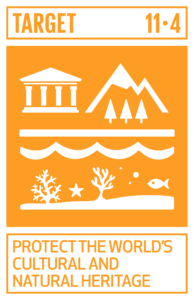Ethnography on the Kolkata Wetlands: Historically Enriched Relevant Intervention through ‘Toolkit’ Aided Grassroots Engagement (HERITAGE)
‘Wake up to the Wetlands’ is guided by community ecoguides and dD experts – a walking tour taking visitors into the East Kolkata Wetlands. It offers firsthand learnings from the community, experience of the everyday activities in EKW, enjoying local transport, exploring native and migratory birds within the unique flora-fauna and much more. Nobina di (Disappearing Dialogues).
Kolkata Wetlands. Aishik Bandopadhyay.
The 12,500 hectares Kolkata wetlands is connected to the municipal sewage canals. It evolved as an input and output geared to the requirements of the city in terms of receiving wastewater and producing sewagefed crops and fish. Kolkata does not have a separate sewage treatment plant – the wetlands recycle 750 million litres of effluent and generates 22 tonnes of fish and 150 tonnes of vegetables per day. Using nature’s services like sunshine, algae, coliform bacteria, water hyacinth, wastewater is recycled through ‘low-cost folk technology’ along intergenerational transmission of traditional knowledge of fishers. It is a heritage lifeworld, awaiting detailed documentation of everyday spatialities and quotidian practices through an ‘ethnographic’ approach combining conventional ethnographies with visualization techniques.
In this PEIP, our team will train young investigators (or ‘participant ethnographers’ (PEs)) on the SMUS Toolkit after a contextual-situational analysis of the site. This will include a series of workshop-cum-trainings where we will be closely working with the PEs to gauge the efficacy of the Toolkit, finally generating ethnovisual outputs such as z-cards, knowledge brochures, coproduced documentaries, etc. The target is to develop a roadmap through which the heritage wetlands can be conserved through increased awareness, participation, involvement and engagement of multiple stakeholders.

Goal: Strengthen efforts to protect and safeguard the world’s cultural and natural heritage by 2030.
Definition: Total per capita expenditure on the preservation, protection and conservation of all cultural and natural heritage, by source of funding (public, private), type of heritage (cultural, natural) and level of government (national, regional, and local/municipal).
The Disappearing Dialogues Collective (DD) is a dynamic platform for creative engagement and cultural expression that aims to foreground everyday practices and environmental awareness of a particular socio-spatial reality through collaborative, coproduced arts practices.
In working closely with children and pedagogical processes, DD looks at art as a situated, embedded practice that enables an alternative mode of learning about individual and collective socio-cultural identities. It also makes possible trajectories of socio-spatial activism and transformation from a deeply rooted standing.
Contact: disappearingdialogues@gmail.com